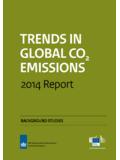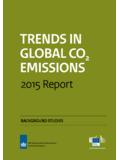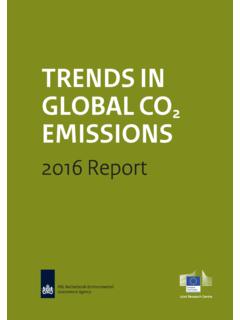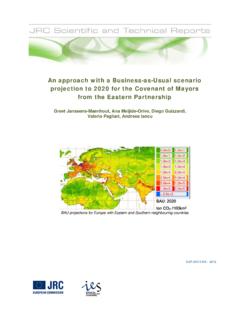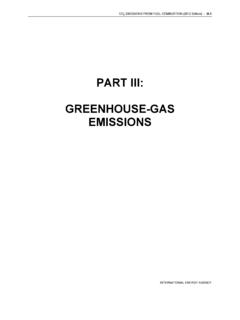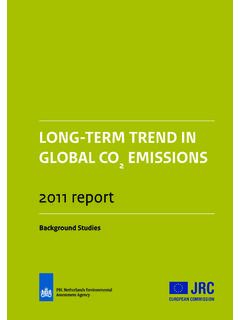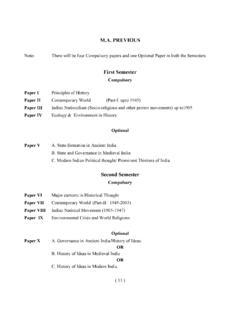Transcription of TRENDS IN GLOBAL CO EMISSIONS - …
1 TRENDS IN. GLOBAL . CO2 EMISSIONS . PBL Netherlands Environmental Assessment Agency 2013 REPORT. Mailing address PO Box 30314. 2500 GH The Hague The Netherlands Visiting address Oranjebuitensingel 6. 2511VE The Hague T +31 (0)70 3288700. and European Commission Joint Research Centre Institute for Environment and Sustainability BACKGROUND STUDIES. Mailing address via Fermi, 2749, TP290. 21027 Ispra (VA). Italy T +39 0332 78 5831. October 2013. TRENDS IN GLOBAL CO2 EMISSIONS : 2013 Report . TRENDS in GLOBAL CO2 EMISSIONS : 2013 Report Responsibility PBL Netherlands Environmental Assessment Agency PBL Netherlands Environmental Assessment Agency The Hague, 2013 Institute for Environment and Sustainability (IES) of the ISBN: 978-94-91506-51-2 European Commission's Joint Research Centre (JRC). PBL publication number: 1148. JRC Technical Note number: JRC83593 Graphics EUR number: EUR 26098 EN Beeldredactie PBL. Corresponding author Production coordination PBL Publishers Authors Layout Jos Olivier (PBL),Greet Janssens-Maenhout (IES-JRC), Martin Middelburg, VijfKeerBlauw Marilena Muntean (IES-JRC), Jeroen Peters (PBL).
2 Acknowledgements This report was drafted with input from many colleagues, gathered over several years. The authors would like to thank Pieter Boot (PBL) for the final review, Laurens Brandes (PBL), Edwin Schaaf (JRC-IES), Gabriel Oreggioni (formerly JRC-IES), Apollonia Miola (JRC-IES) for their input, and Julian Wilson (JRC-IES), Jens Hjorth (JRC-IES), Vangelis Tzimas (JRC-IET), Michel den Elzen (PBL) and Martijn Verdonk (PBL) for their review of an earlier draft. We also like to thank Willem Thomas van Ierland (EC, DG CLIMA), Velina Pendolowska (EC, DG CLIMA), Robert A. Field (University of Wyoming) and Robert Socolow (Princeton University) for their critical review and suggestions. This publication can be downloaded from: or Parts of this publication may be reproduced, providing the source is stated, in the form: Oliver JGJ, Janssens-Maenhout G, Muntean M and Peters JAHW (2013), TRENDS in GLOBAL CO2 EMISSIONS ; 2013 Report, The Hague: PBL Netherlands Environmental Assessment Agency.
3 Ispra: Joint Research Centre. PBL Netherlands Environmental Assessment Agency is the national institute for strategic policy analyses in the fields of the environment, nature and spatial planning. We contribute to improving the quality of political and administrative decision-making, by conducting outlook studies, analyses and evaluations in which an integrated approach is considered paramount. Policy relevance is the prime concern in all our studies. We conduct solicited and unsolicited research that is both independent and always scientifically sound. As the European Commission's in-house science service, the Joint Research Centre's mission is to provide EU policies with independent, evidence-based scientific and technical support throughout the whole policy cycle. Working in close cooperation with policy Directorates-General, the JRC addresses key societal challenges while stimulating innovation through developing new methods, tools and standards, and sharing its know-how with the Member States, the scientific community and international partners.
4 Key policy areas include: environment and climate change; energy and transport; agriculture and food security; health and consumer protection; information society and digital agenda; safety and security, including nuclear; all supported through a cross-cutting and multidisciplinary approach. 2 | Ruimtelijke opgaven in beeld. Achtergronden bij de Ex-ante evaluatie Structuurvisie Infrastructuur en Ruimte . Contents Summary 4. 1 Introduction 6. 2 Results 8. Slowdown in the historical increase in GLOBAL CO2 EMISSIONS 8. Different TRENDS in the six largest emitting countries/regions 10. Comparison between EMISSIONS in the various countries 15. Gas flaring EMISSIONS 20. Shale gas and oil production through hydraulic fracturing and oil sands exploitation 21. Industrial non-combustion sources 25. Climate change mitigation in the 21st century 26. 3 TRENDS in energy supply and consumption 32. Introduction 32. TRENDS in fossil-fuel consumption and fuel mix 34.
5 TRENDS in energy efficiency improvements 34. TRENDS in renewable energy sources 36. TRENDS in nuclear energy 37. Carbon capture and storage 39. 4 Conclusion: signs of a slowdown in the annual increase in GLOBAL CO2 42. Annex 46. Annex 1 Methodology and data sources over the 2010 2012 period 46. List of abbreviations and definitions 51. References 53. | 3. Summary The increase in GLOBAL EMISSIONS of carbon dioxide (CO2) noted a 1% decrease. Although China's CO2 EMISSIONS per from fossil-fuel combustion and other smaller industrial capita are comparable to those in the EU and almost half sources the main cause of human-induced GLOBAL of US EMISSIONS per capita, its CO2 EMISSIONS per USD in warming slowed down in 2012, while the GLOBAL average Gross Domestic Product (GDP) are almost double those of annual growth rate of ppm in atmospheric CO2 the EU and United States and similar to those of the concentrations in 2012 was rather high.
6 Russian Federation. Actual GLOBAL EMISSIONS increased by over 2011, China's large economic stimulus package, intended to reaching a total of billion tonnes in 2012. After a avoid a decrease in annual economic growth during the correction for the leap year 2012, this increase was recent GLOBAL recession, has come to an end. With reduced to only , compared with an average annual electricity and energy increases at half the pace of GDP. increase of since 2000. The CO2 emission trend growth, the energy intensity per unit of GDP declined in mainly reflects energy-related human activities which, 2012 by , which is twice as fast as in 2011. This slower over the past decade, were determined by economic and structurally changed growth puts the country back on growth, particularly in emerging countries. In 2012, a track, in combination with a national energy consumption decoupling' of the increase in CO2 EMISSIONS from GLOBAL target for 2015, to meet its 2015 target according to the economic growth (in GDP) took place, which points to a 12th Five Year Plan, with an almost 17% cumulative shift towards less fossil-fuel intensive activities, more use reduction in energy intensity per unit of GDP, compared of renewable energy and increased energy saving.
7 To 2010. China also increased its hydropower capacity and output by 23% in 2012, which had a significant mitigating Comparing regional CO2 emission TRENDS reveals large effect of about percentage points on its CO2 EMISSIONS differences in underlying causes, which complicates the in 2012. evaluation of the robustness of observed TRENDS . For 2012, remarkable TRENDS were seen in the top 3 emitting In that year, China's average carbon dioxide EMISSIONS of countries/regions, which accounted for 55% of total tonnes CO2 per capita resulted from a smoothing of GLOBAL CO2 EMISSIONS . Of these three, China (29% share) their CO2 increase by only 3% after the about 10% annual increased its CO2 EMISSIONS by 3%, which is low compared growth rates of the previous decade. This 2012 increase in with annual increases of about 10% over the last decade. fuel consumption was mainly driven by the increase in In the United States (16% share) and the European Union building construction and expansion of infrastructure, as (11% share) CO2 EMISSIONS decreased by 4% and , indicated by the growth in cement and steel production.
8 Respectively. In addition, in India and Japan, EMISSIONS Although the United States, with tonnes CO2 per increased by 7% and 6%, and the Russian Federation capita in 2012, showed a decrease in CO2 EMISSIONS since 4 | TRENDS in GLOBAL CO2 EMISSIONS : 2013 Report 2005, they still ranks among the major industrialised sources solar, wind and biofuel also increased with countries with the highest emission levels. In 2012, with accelerating speed: it took 15 years since 1992 for the an economic growth of 2%, their CO2 EMISSIONS share to double from to , but only 6 more years decreased by 4%, mainly because of a further fuel shift to do so again, to in 2012. from coal to gas in the power sector, due to the low gas price. In recent years, the United States expanded shale The small increase in EMISSIONS in 2012 of may be the gas fracturing and has now become the largest natural first sign of a slowdown in the increase in GLOBAL CO2. gas producer in the world.
9 Over the past 5 years, the EMISSIONS , and ultimately of declining GLOBAL EMISSIONS , if share of shale gas increased to one third of the total US (a) China achieves its own target of a maximum level of gross gas production and the share of shale oil in 2012 energy consumption by 2015 and its shift to gas with a was almost one quarter of total US crude oil production. natural gas share of 10% by 2020; (b) the United States The European Union, as a whole, experienced an continues a shift its energy mix towards more gas and economic recession in 2012 with the EU27's GDP declining renewable energy; and (c) in the European Union, by , compared to 2011, and actual CO2 EMISSIONS Member States agree on restoring the effectiveness of declining by , which is less than the 2011 decrease of the EU EMISSIONS Trading System to further reduce actual The main reasons for this are a decrease in primary EMISSIONS . energy consumption of oil and gas, by 4% and 2%.
10 Respectively , a decrease in road freight transport by 4%, Obviously, it is uncertain how the GLOBAL society will and a decrease of 2% in total EMISSIONS from power develop over time and which economic and technological generation and manufacturing installations participating TRENDS will continue; in particular, with respect to GLOBAL in the EU EMISSIONS Trading System (EU ETS). While the and regional prices of different fossil fuels and the shares total CO2 EMISSIONS from power generation in EU27 of nuclear power and renewable energy sources. decreased by in 2012, very different TRENDS were However, there is additional uncertainty due to possible noticed for the different EU Member States, in particular major changes in various areas that would have a large for coal. The use of coal in Europe's energy mix for impact on GLOBAL energy use. electricity production became attractive again. In 2012, For example: increased coal consumption was observed in the United rising production of shale gas may affect natural gas Kingdom (+24%; the highest consumption since 2006), prices worldwide.
